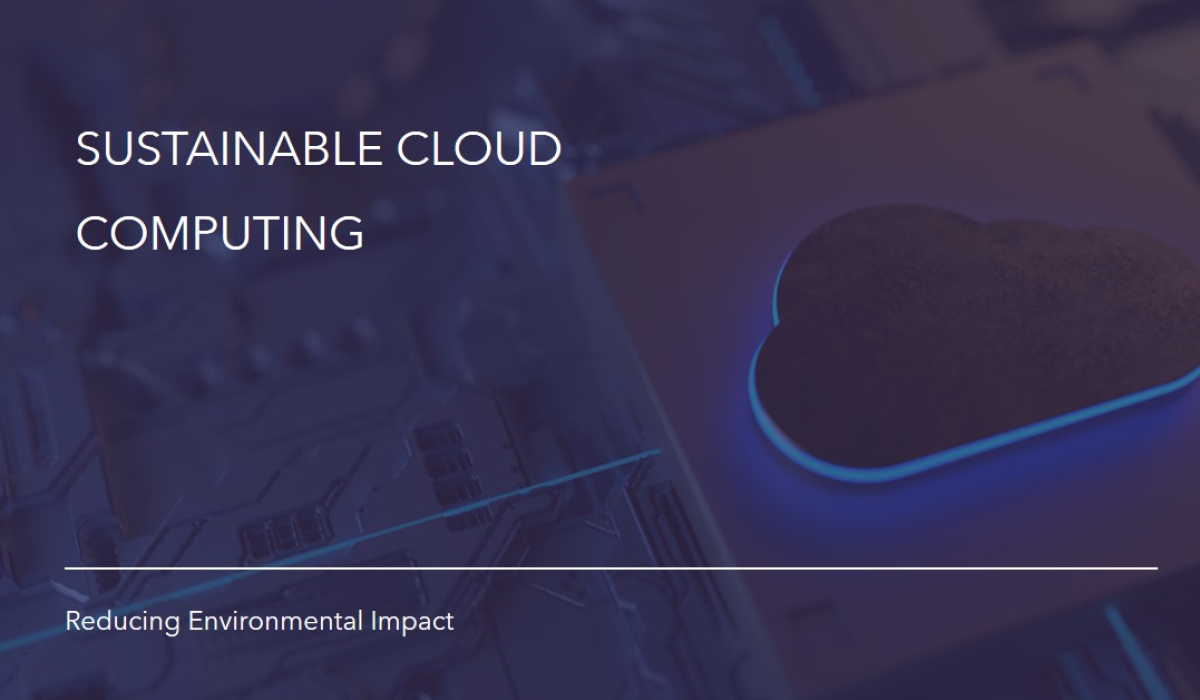The ever-growing digital landscape relies heavily on data centers, which can be significant energy consumers. This raises concerns about the environmental impact of cloud computing. However, cloud computing can also be a powerful tool for promoting sustainability through a concept known as the Green Cloud.
A Green Cloud refers to cloud computing practices that prioritize environmental responsibility. This translates to reducing the carbon footprint of cloud services and promoting resource efficiency. In today’s world, where environmental consciousness is paramount, adopting Green Cloud practices holds significant importance.
How Cloud Computing Contributes to Environmental Sustainability
Cloud computing offers several advantages that can significantly contribute to environmental sustainability. Here’s how:
- Optimized Resource Use: Traditional IT infrastructure often involves underutilized servers and hardware. Cloud computing allows for virtualization, where a single physical server can host multiple virtual machines, maximizing resource utilization and reducing the overall number of physical servers needed. This translates to lower energy consumption.
- Green Operations Practices: Cloud providers have a vested interest in efficiency as it reduces their operational costs. This incentivizes them to adopt green practices like using energy-efficient servers, implementing cooling systems that optimize energy use, and utilizing renewable energy sources to power their data centers.
By adopting cloud computing and partnering with providers who prioritize Green Cloud initiatives, organizations can significantly reduce their environmental footprint and contribute to a more sustainable future.
Green Cloud: Cloud Computing’s Sustainable Edge
While the digital world thrives on cloud computing, the environmental impact of data centers can’t be ignored. Here’s a breakdown of how cloud-based solutions compare to traditional data centers, focusing on the Green Cloud approach:
Environmental Impact: Traditional vs. Cloud
- Traditional Data Centers: These facilities house vast amounts of physical servers constantly running, requiring significant energy for power and cooling. They often rely on conventional energy sources like coal or natural gas, leading to a high carbon footprint. Additionally, underutilized servers contribute to wasted energy.
- Cloud-Based Solutions: Cloud computing utilizes virtualization, where a single physical server can host multiple virtual machines for different users. This dramatically reduces the number of physical servers needed, leading to lower overall energy consumption. Cloud providers also have a strong incentive to be energy efficient due to operational cost savings.
Multitenancy: A Key to Green Efficiency
- Multitenancy is a core concept of cloud computing where multiple users share the resources of a single physical server. This eliminates the need for individual companies to maintain their own underutilized servers, leading to significant resource optimization and reduced energy demand. Imagine an apartment building – multiple tenants share the infrastructure (electricity, water) efficiently, compared to everyone having their own house.
Clean Energy Sources: Powering the Green Cloud
- Cloud Providers and Renewables: Leading cloud providers are increasingly investing in renewable energy sources like wind and solar farms to power their data centers. This shift from conventional energy sources reduces greenhouse gas emissions and promotes a more sustainable cloud infrastructure.
Sustainable Practices in Cloud Engineering
Cloud computing offers a powerful and scalable solution for businesses, but with that power comes responsibility. Here are some best practices to ensure you’re using the cloud in a sustainable way:
- Right-size Your Resources: Avoid overprovisioning! Just as you wouldn’t pay for electricity for a room you never use, don’t allocate more cloud resources than your application truly needs. Carefully analyze your usage patterns and scale your cloud resources (CPU, memory, storage) accordingly. This optimizes costs and reduces energy consumption.
- Green Code is Efficient Code: The code you write for your cloud applications can significantly impact its environmental footprint. Focus on writing clean, efficient code that utilizes resources optimally. This might involve techniques like optimizing database queries, avoiding unnecessary data processing, and implementing caching mechanisms. Remember, lean code means a leaner environmental footprint.
- Monitor and Manage for Efficiency: Knowledge is power, especially when it comes to cloud sustainability. Utilize cloud provider tools and monitoring services to track your resource usage. Identify idle resources and workloads that can be scaled down or turned off during non-peak hours. Proactive monitoring allows you to identify areas for improvement and ensure you’re not unknowingly contributing to wasted energy.
- Embrace Serverless for Sustainable Gains:
Serverless computing is an emerging cloud paradigm where you pay only for the resources your code actually uses. This eliminates the need for constant server provisioning and management, leading to significant energy savings. Consider utilizing serverless functions for tasks that are short-lived or unpredictable in their resource demands.
nnovative Solutions for Sustainability in the Cloud
The Green Cloud movement is constantly evolving, with new approaches emerging to push the boundaries of sustainable cloud computing. Here are some exciting innovations that are making a difference:
- Containerization and Microservices for Green Efficiency: Traditional monolithic applications are resource-hungry. Containerization breaks down applications into smaller, independent units (microservices) packaged in containers. This allows for:
- Scalability: Only the microservices that are actively needed are scaled up or down, reducing overall resource consumption.
- Resource Efficiency: Containers share the operating system of the underlying host machine, eliminating the need for multiple virtual machines, leading to lower energy use.
- AI-Driven Workload Optimization: Artificial intelligence is finding its way into cloud management, playing a crucial role in sustainability. AI-powered tools can:
- Predict Resource Needs: Machine learning algorithms can analyze usage patterns and predict future resource demands. This allows for proactive scaling, ensuring resources are available when needed but not wasted during idle periods.
- Optimize Workload Placement: AI can intelligently distribute workloads across geographically dispersed data centers, considering factors like renewable energy availability and minimizing data transfer distances.
- Edge Computing for Green at the Periphery: Edge computing brings processing power and storage closer to the source of data, in devices at the network’s edge. This reduces the need for long-distance data transfers to centralized cloud data centers, leading to significant energy savings. Imagine processing sensor data locally instead of sending it across continents – less travel means less energy used.
These innovative solutions, along with the best practices outlined earlier, paint a bright picture for a more sustainable future for cloud computing. By embracing these advancements, we can ensure the digital world thrives without compromising the well-being of our planet.
Cloud computing offers immense potential for innovation and progress, but it’s crucial to ensure this progress happens in harmony with the environment. The Green Cloud movement presents a powerful solution, and by adopting sustainable practices and embracing innovative solutions, we can significantly reduce the environmental impact of cloud computing.





